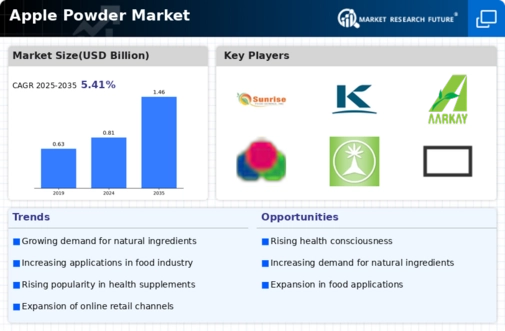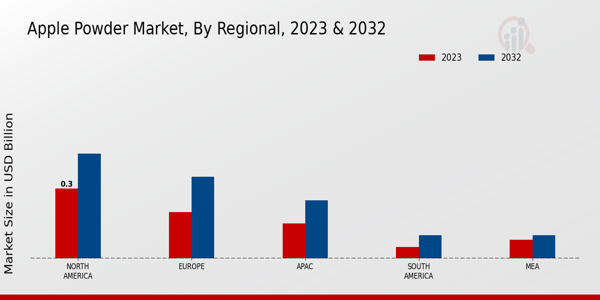Market Growth Projections
The Global Apple Powder Market Industry is poised for substantial growth, with projections indicating a market value of 0.81 USD Billion in 2024 and an anticipated increase to 1.46 USD Billion by 2035. This growth trajectory suggests a compound annual growth rate of 5.5% from 2025 to 2035. Such figures reflect the increasing consumer demand for apple powder across various applications, including food and beverages. The market's expansion is likely influenced by factors such as rising health consciousness, innovations in food technology, and the growing popularity of organic products. These dynamics collectively indicate a promising future for the apple powder market.
Rising Health Consciousness
The Global Apple Powder Market Industry is experiencing growth driven by an increasing awareness of health and wellness among consumers. As individuals seek natural and nutritious food options, apple powder, known for its rich antioxidant content and dietary fiber, becomes an appealing choice. This trend is particularly evident in regions where consumers are shifting towards plant-based diets. The market is projected to reach 0.81 USD Billion in 2024, indicating a robust demand for healthy ingredients. This shift towards healthier eating habits suggests that apple powder could play a significant role in various food products, enhancing their nutritional profiles.
Innovations in Food Technology
Technological advancements in food processing are propelling the Global Apple Powder Market Industry forward. Innovations such as freeze-drying and spray-drying techniques enhance the quality and shelf life of apple powder, making it more appealing to manufacturers. These technologies allow for the preservation of flavor and nutrients, which is crucial for maintaining consumer interest. As food companies increasingly adopt these technologies, the market is likely to see a surge in high-quality apple powder products. This trend may contribute to the projected market growth, as consumers seek premium ingredients in their food products.
Growth in the Organic Food Sector
The Global Apple Powder Market Industry is benefiting from the burgeoning organic food sector. As consumers become more discerning about food sourcing, the demand for organic apple powder is on the rise. Organic products are perceived as healthier and more environmentally friendly, which aligns with current consumer preferences. This trend is particularly strong in North America and Europe, where organic food sales are increasing significantly. The anticipated compound annual growth rate of 5.5% from 2025 to 2035 reflects the potential for organic apple powder to capture a larger market share, driven by consumer demand for clean-label products.
Increased Demand for Natural Sweeteners
The Global Apple Powder Market Industry is witnessing a shift towards natural sweeteners as consumers become more health-conscious. Apple powder serves as a natural alternative to refined sugars, appealing to those looking to reduce sugar intake without sacrificing flavor. This trend is particularly relevant in the formulation of health foods and beverages, where the demand for clean-label ingredients is rising. As the market evolves, the integration of apple powder as a sweetening agent could enhance its appeal, potentially driving growth in the sector. This shift aligns with broader trends towards healthier eating habits.
Expanding Applications in Food and Beverage
The versatility of apple powder is a key driver in the Global Apple Powder Market Industry. It finds applications in a variety of sectors, including snacks, beverages, and baked goods. Manufacturers are increasingly incorporating apple powder into their products to enhance flavor and nutritional value. For instance, the use of apple powder in smoothies and health bars is gaining traction, appealing to health-conscious consumers. This expanding application base is likely to contribute to the market's growth, with projections indicating a rise to 1.46 USD Billion by 2035. Such diversification in product offerings could further stimulate demand.









